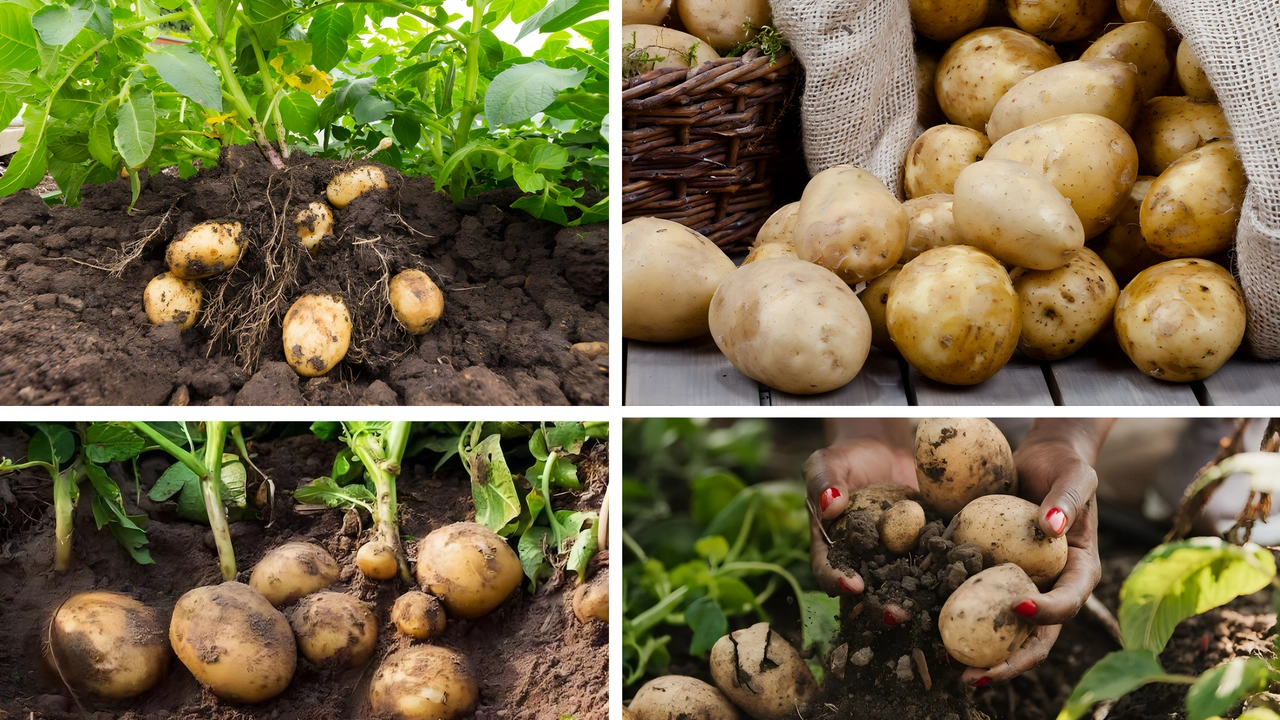Join on WhatsApp
Get the latest updates directly on WhatsApp – motivation, news & more!
Growing potatoes at home can be one of the most satisfying gardening experiences, especially when you’re aiming for the perfect harvest. Whether you’re planting in your backyard, in containers, or on a small farm, understanding the complete process—from selecting the right variety to proper care and harvesting techniques—is essential for success. In this complete guide to planting, care, and harvest, we’ll explore every stage of how to grow perfect potatoes, ensuring you enjoy healthy, abundant tubers every season. This comprehensive approach combines practical gardening knowledge with tried-and-true care methods to produce potatoes that are flavorful, firm, and disease-free.

Choosing the Right Variety to Grow Perfect Potatoes
The journey of how to grow perfect potatoes starts with selecting the right seed potatoes. Different potato varieties serve different culinary and growing needs. For boiling, roasting, mashing, or baking, the variety you choose can greatly influence your yield and quality. It’s essential to select certified seed potatoes that are disease-free and suited to your local climate and soil conditions.
For example:
- Yukon Gold: Ideal for general use, smooth texture, early maturing.
- Russet Burbank: Best for baking and frying, late maturing.
- Red Norland: Good for boiling, early harvest.
- Fingerling Potatoes: Gourmet type, flavorful, excellent for roasting.
When learning how to grow perfect potatoes, choosing the right type ensures that your planting, care, and harvesting efforts pay off with top-quality tubers.
Preparing Soil for the Best Potato Planting and Care
Soil preparation plays a crucial role in the complete guide to planting, care, and harvest. Potatoes thrive in loose, well-draining, slightly acidic soil with a pH between 5.0 and 6.5. To grow perfect potatoes, begin by removing rocks and compacted soil, as these hinder root and tuber development. You can enrich your soil with compost, well-rotted manure, or organic matter weeks before planting.
Raised beds or hilled rows are recommended for better drainage, especially in regions with heavy rainfall. The looser the soil, the more room potatoes have to expand underground, which is a key factor in producing uniform and healthy tubers. Proper soil care ensures consistent moisture levels and nutrient availability, critical components of how to grow perfect potatoes.
Planting Techniques in the Complete Guide to Grow Perfect Potatoes
The planting phase is one of the most vital parts of how to grow perfect potatoes. Begin by cutting large seed potatoes into pieces, each with at least one or two eyes. Allow them to cure for a day or two to prevent rotting when placed in the soil.
Plant them 4–6 inches deep with the eyes facing upward. Space the pieces 12–15 inches apart in rows that are 24–30 inches apart. After covering with soil, continue to monitor and care for the plants as they emerge. When shoots reach 6 inches tall, begin the hilling process by mounding soil around the base of each plant. This protects the developing tubers from sunlight and encourages the formation of more potatoes along the buried stem.
This step-by-step planting method supports your goal to grow perfect potatoes and prepares your crop for strong, healthy growth.
Essential Potato Plant Care for a Healthy Harvest
Proper care is at the core of how to grow perfect potatoes. This includes consistent watering, disease prevention, and nutrient management. Potatoes require about 1–2 inches of water per week. The soil should be kept consistently moist but not soggy, especially during the flowering phase when tubers are forming.
To grow perfect potatoes, avoid over-fertilizing with nitrogen. While nitrogen promotes leafy growth, too much can reduce tuber production. Instead, use a balanced fertilizer or one slightly higher in phosphorus and potassium. Regular weeding, mulching, and hilling throughout the growing season help maintain soil moisture and temperature while suppressing weeds.
Pay close attention to pest and disease management. Potato beetles, aphids, and fungal diseases like late blight can significantly reduce yield. Organic options like neem oil, row covers, and crop rotation are effective care techniques in this complete guide to growing potatoes.
Harvesting: The Final Step to Grow Perfect Potatoes
Knowing when and how to harvest is a key part of the complete guide to planting, care, and harvest. For new potatoes (small and tender), harvesting can begin about 60 days after planting, usually 2–3 weeks after the plants flower. For storage potatoes, wait until the foliage yellows and dies back—about 90–120 days.
Stop watering a week or two before harvest to allow the skins to set. Use a garden fork or hands to dig up the potatoes gently, being careful not to bruise or cut them. Once harvested, allow them to cure in a cool, dark place with good ventilation for about 1–2 weeks. This step thickens the skin and extends shelf life, which is essential if your goal is to grow perfect potatoes for long-term use.
Storing Potatoes for Long-Term Freshness and Quality
After harvesting, proper storage is essential in your journey of how to grow perfect potatoes. Potatoes should be stored in a cool, dark, well-ventilated area with temperatures between 38–45°F (3–7°C). Avoid refrigeration, as this can turn the starches into sugars and affect taste.
Never wash potatoes before storing. Moisture can promote mold and rot. Instead, brush off excess soil and store them in breathable bags or wooden crates. Check regularly for signs of sprouting or decay, and remove any affected potatoes immediately.
Storing your crop properly is part of the complete guide to planting, care, and harvest and ensures that your effort to grow perfect potatoes lasts well beyond harvest time.
Troubleshooting Common Issues When You Grow Perfect Potatoes
Even with the best planning and care, problems can occur. Here’s a quick troubleshooting guide to address common issues in your quest to grow perfect potatoes:
| Problem | Cause | Solution |
|---|---|---|
| Green Potatoes | Sunlight exposure | Hill up soil regularly |
| Small Tuber Size | Poor soil or lack of nutrients | Enrich soil with compost and fertilize properly |
| Scab on Potatoes | Alkaline soil | Lower soil pH with organic matter |
| Wilting Plants | Overwatering or blight | Improve drainage, remove infected plants |
| No Potatoes Forming | Excess nitrogen or early harvest | Use balanced fertilizer, wait until maturity |
Addressing these challenges quickly and effectively is crucial to follow the complete guide to planting, care, and harvest and to ensure you continue to grow perfect potatoes season after season.
Grow Perfect Potatoes in Containers or Small Spaces
Even with limited space, it is entirely possible to grow perfect potatoes using containers. Use large grow bags, barrels, or deep pots with drainage holes. Fill the bottom with 4–6 inches of soil, plant the seed potatoes, and cover with more soil. Continue to add soil or mulch as the plants grow.
Container growing follows the same principles as traditional gardening in terms of planting, care, and harvest. With regular watering, appropriate fertilization, and proper sunlight, you can enjoy a high-quality harvest of perfect potatoes from your balcony, patio, or small garden area.
This flexible method is an excellent part of the complete guide to planting, care, and harvest for those with space constraints.
Conclusion: Your Roadmap on How to Grow Perfect Potatoes
Mastering how to grow perfect potatoes requires a blend of planning, technique, and consistent care. From selecting the right variety and preparing nutrient-rich soil to following smart planting strategies and diligent maintenance, every step contributes to a successful harvest. Proper harvesting and storage techniques ensure your efforts last well beyond the growing season. Whether you’re growing in the ground or in containers, this complete guide to planting, care, and harvest gives you all the tools you need to succeed.
By applying the tips and strategies in this comprehensive guide, you’ll not only learn how to grow perfect potatoes—you’ll actually do it. With time, patience, and a little soil under your nails, you’ll enjoy fresh, homegrown potatoes that are tastier, healthier, and more satisfying than any store-bought variety.


